Bioluminescence
Humans have long been fascinated by organisms that can produce light. Aristotle, who was a scientist as well as a philosopher, wrote the first detailed descriptions of what he called “cold light” more than 2,000 years ago. More recently, pioneering researchers like World War II Army veteran Emmett Chappelle and deep submergence vehicle pilot Edith Widder advanced the study of this phenomenon with novel technologies. At least 94 living organisms produce their own light through a chemical reaction inside their bodies – an ability called bioluminescence. Examples include luminous fireflies, algae that create “glow-in-the-dark” bays, small crustaceans with intricate courtship displays, and deep-sea fish and coral. Yet despite its widespread occurrence, scientists don’t yet know when or where it first emerged, or its original function. As marine biologists who specialize in deep-sea habitats, we know that bioluminescence is particularly common i...
Curious Kids is a series for children of all ages. If you have a question you’d like an expert to answer, send it to curiouskidsus@theconversation.com. Is there life in the sea that hasn’t been discovered? – Haven W., age 12, McKinney, Texas Imagine going to a place on Earth where no one has ever been. There are many locations like that in the ocean, which covers more than 70% of our planet. In the ocean, creatures live at many different depths, just as animals and birds live at different heights in a forest. Every ocean life form has to find a way to gather nourishment, reproduce and contribute to an ecological community. The ocean is thousands of feet deep in many areas and offers millions of opportunities for life to thrive. Biologists don’t know how many species live in the ocean, but they estimate that fewer than 10% have been described. Black and white sm...

